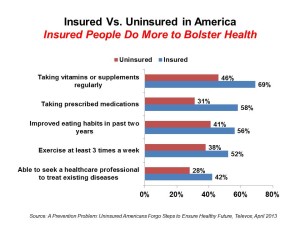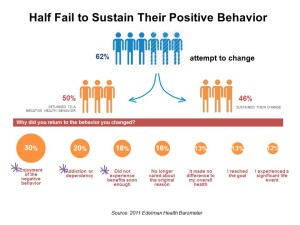 If you have health insurance, chances are you take several actions to bolster your health such as take vitamins and supplements (which 2 in 3 American adults do), take medications as prescribed (done by 58% of insured people), and tried to improve your eating habits in the past two years (56%). Most people with insurance also say they exercise at least 3 times a week.
If you have health insurance, chances are you take several actions to bolster your health such as take vitamins and supplements (which 2 in 3 American adults do), take medications as prescribed (done by 58% of insured people), and tried to improve your eating habits in the past two years (56%). Most people with insurance also say they exercise at least 3 times a week.
Fewer people who are uninsured undertake these kinds of health behaviors: across-the-board, uninsured people tend toward healthy behaviors less than those with insurance.
This is The Prevention Problem, gleaned from a survey conducted by TeleVox which has published various reports under the company’s Healthy World initiative. The chart illustrates what TeleVox, a communications support company for health providers, calls out as “The Ugly Truth” — that is, the disparity between the health and wellness status of the insured versus the uninsured.
Other key findings from the survey include:
- Fewer than 1 in 5 uninsured people consider themselves to be extremely healthy
- People without health insurance are less knowledgeable about preventive care: 33% were uncertain what constitutes prevention, versus 16% of insured people
- Still, 91% of the uninsured believe that some form of prevention is important, and 81% of the uninsured say that taking preventive care measures can save patients money
- Nonetheless, 17% of the uninsured who have been given preventive health recommendation gave themselves a grade of “F” when it came to following this information up.
The consumer survey was conducted among 1,015 Americans age 18 and over in April 2013, along with a poll of over 2,200 health providers.
Health Populi’s Hot Points: Three-quarters of people die from noncommunicable diseases (NCDs) — conditions like heart disease, diabetes, various cancers among them — which are largely amenable to prevention and changing lifestyle behaviors. There are 4 such behaviors that move the needle on chronic disease:
- Doing more physical activity
- Eating healthy food in healthy proportions
- Drinking alcohol moderately
- Quitting smoking.
Fewer people who lack health insurance tend to make fewer of these healthy choices.

It’s not easy to change health behaviors. The Edelman Health Barometer of 2011 found that two-thirds of people try to change a behavior in a past year, and only one-half sustain that change, lapsing back into the original (unhealthy) choice.
As uninsured people in America are invited to access health plans through health insurance exchanges (marketplaces), folks will be exercising new muscles. First, the lack of knowledge of how to shop for health insurance, and how to evaluate different options across different health plans available in the local marketplaces; and second, once enrolled in a health plan, how to use the health system. This new-new milieu means finding a primary care doctor, versus continuing to use the emergency department for an infection or to investigate a lump that went unchecked for many months before attaining insurance coverage.
Learning to be health literate, and health plan literate, will be Job 1 for the newly-insured. TeleVox’s survey shows us there is much education to be done. Setting up a health insurance exchange — which is heavy lifting in itself — is but one pillar of getting the uninsured insured. Once insured, there’s new workflow for people to embrace and implement. Health behavior change is hard, and one of those behaviors will be shifting newly-insured consumer mindsets from expensive, inappropriate health care settings (namely, hospital departments) to lower-cost, more appropriate and convenient providers (e.g., primary care, retail health clinics, worksite clinics, school-based clinics, and the like).
That’s the health care utilization piece of the puzzle. The other big opportunity is to promote prevention and healthy behaviors where the newly insured live, work, play and pray — in their home and communities. That’s where the local food system, schools, workplaces, retail and community organizations play a huge role on a daily basis to help people access local resources to improve on food choices, increase physical activity, and support smoking cessation (very amenable to social networks and competitions).
While costs of serving the newly insured may raise aggregate health care costs in the U.S. in the first years of health reform implementation, in the longer run, the public’s health burden of disease could benefit from getting people into preventive programs sooner…thus, closing the health/wellness gap that is The Ugly Truth of the insured and the uninsured.




 Interviewed live on BNN Bloomberg (Canada) on the market for GLP-1 drugs for weight loss and their impact on both the health care system and consumer goods and services -- notably, food, nutrition, retail health, gyms, and other sectors.
Interviewed live on BNN Bloomberg (Canada) on the market for GLP-1 drugs for weight loss and their impact on both the health care system and consumer goods and services -- notably, food, nutrition, retail health, gyms, and other sectors. Thank you, Feedspot, for
Thank you, Feedspot, for  As you may know, I have been splitting work- and living-time between the U.S. and the E.U., most recently living in and working from Brussels. In the month of September 2024, I'll be splitting time between London and other parts of the U.K., and Italy where I'll be working with clients on consumer health, self-care and home care focused on food-as-medicine, digital health, business and scenario planning for the future...
As you may know, I have been splitting work- and living-time between the U.S. and the E.U., most recently living in and working from Brussels. In the month of September 2024, I'll be splitting time between London and other parts of the U.K., and Italy where I'll be working with clients on consumer health, self-care and home care focused on food-as-medicine, digital health, business and scenario planning for the future...